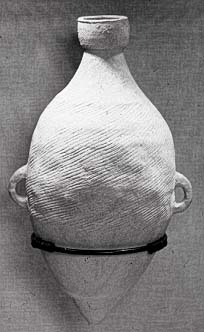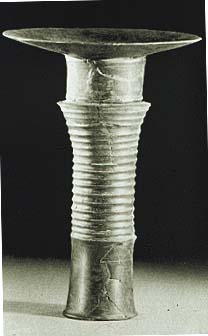
Keynotes 2
Peopling Asia

The 'Out-of-Africa'-theory "supported by genetic evidence suggests that all modern humans derive from African ancestors who lived between about 285,000 and 150,000 years ago, and that all modern non-African humans are descendants of a single group of this ancestral population that migrated out of Africa around 100,000 years ago." (John Haywood et al., Historical Atlas of the Ancient World, 4,000.000-500 BC. Oxford: MetroBooks 2001, p. 1.05).
Some Chinese archaeologists are convinced that pre-human Ramapithecus was the ancestor of Homo erectus, a theory which could not be proven. The period of the appearence of Homo erectus in China can be approx. dated to a time before 200,000 years.
Early Homo sapiens appeared about 200,000 and 50,000 years ago, and the appearence of Homo sapiens sapiens may be dated back 50,000 to 12,000 years. (For more information see Kwang-chih Chang, The Archaeology of Ancient China. New Haven: Yale University Press 1986; Gina L. Barnes, China, Korea, and Japan. The Rise of Civilization in East Asia. London: Thames and Hudson 1993.)

The beginnings of agriculture. Indicated are the earliest use of the potter's wheel before 3000 BCE and the earliest centers of metallurgy (copper, bronze), 6000-2000 BCE. (Haywood 2001, 1.03).
The Neolithic Revolution
is characterized by:
• agriculture: advanced technology resulted in surplus which could support
an increasing population
• town building: large settlements indicate a sedentary society
• flood control & irrigation systems (surplus production)
• script to administer surplus and taxes (and to educate the upper levels
of society)
• production of metal tools and weapons
- 10,000-4000 BCE: bronze (copper + tin+ lead) tools and
weapons were produced
- Between 10,000 BCE and 7000 BCE stone and metal tools were used as well as
clay pots for storing and transporting grain and water.
- The cultivation of wheat, barley, and peas was complemented by the domestication
of dogs, sheep, and goats, around 6000 BCE pigs and cattle were domesticated.
- ca. 7000 BCE: most important cradles of agricultural production: Mesopotamia, mainland Southeast Asia
- Around 6500 BCE: the cultivation of rice becomes popular
in the Yangzi valley.
- Water control projects were prominent sources of labor organization and a
wide scope of agricultural production from the Middle East to Afghanistan.
- Around 3000 BCE: Mesopotamia and India had highly developed urban cultures
with literate bureaucrats, tax collectors, priests, scribes who had been educated
in schools as well as a fully developed agriculture relying on sophisticated
irrigation systems; in East Asia the development started slightly later but
communities which were organized similarly to those of the South Asian neighbors
were established around 2000 BCE.
- During the same period silk production is established, advanced farming cultures
become prominent (Yangshao, Longshan) and the first towns are built in China.
The importance of Southeast Asia in the development of Chinese culture - the basis for East Asian civilizations
For a long time the area around the 'knee' of the Yellow
River was regarded as the cradle of Chinese and East Asian civilization, because
excellently preserved archaelogical finds from this semi-arid area (loess) seemed
to prove that the civilization associated with Chinese culture started here
first.
Yet perishable organic materials could hardly survive in humid, (semi-)tropical
climatic conditions. More recent finds have brought to daylight remains of domesticated
animals such as:
- pigs,
- chickens, and
- water buffalos. In addition
- bronze tools and
- weapons were found which support the theory that civilization developed from
Southeast Asia northward to Southern China. The southern Chinese kingdom of
Nan Yue streched from Guangdong in the East to the area occupied by modern Vietnam
in the West and was ruled in a dual capital system from Guangzhou (Canton) and
Hanoi.
Until the 3rd cent. B.C.E. population, languages, and culture of the southern area showed little distinction. On the contrary, the influence of this culture spread north to the area of modern Zhejiang province.
While northen Vietnam and adjacent South China were sinicized, southern Vietnam and Southeast Asia (Burma, Malaysia, Thailand, Cambodia, Southern Vietnam) came under the influence of India.
The development in the north
The north seems to have developed a millet-cultivating society on an independent pace (e.g. Banpo village near modern Xi'an). From this culture, called Yangshao culture, many examples of painted pottery objects which were formed without a potter's wheel yet were inscribed with ideographs and decorated with red and black geometric patterns have been preserved.

Drawing of Banpo village according to archaeological finds
 model of Banpo village
model of Banpo village
 Banpo
amphora (ca. 4000 BC)
Banpo
amphora (ca. 4000 BC)
 Bowl
with human mask and fish design found in Banpo
Bowl
with human mask and fish design found in Banpo
The Yangshao culture was followed by the Longshan
culture which produced elegant thin black pottery that was thrown on a wheel
and fired at high temperatures (up to 1000 degrees C).
People belonging to the Longshan culture-sphere were the first that used animal
bones for divinatory purposes.

egg-shell thin drinking vessels of Longshan culture

Summing up chapter 1: Characteristics of East Asian Civilizations
Monsoon Asia:
- Summer: the continental landmass heats up and draws in cool air from the ocean. The wind brings rain in spring and summer which supports the growing cycle of staples.
- Winter: the continental landmass cools down and northern winds blow southward to the ocean. The changes of the intense winds were used by international trade with sea-going sailships.

Winter monsoon

Summer monsoon
Vegetable Civilization:
The average diet-system in East Asia contains large quantities
of rice, millet, wheat, barley, as well as vegetables. Little room is available
for pasture. Therefore cereal production and consumption are prominent.
Furthermore, dairy products are associated with the diet of the "barbarian"
nomadic northern cultures which repeatedly in history challenged sedentary East
Asian societies.
Hierarchical Structure of Society:
The ideal government according to Confucian ideals is headed by an authoritarian ruler who cares for the state and his subjects like a father for his family. Good government functions in analogy to a family clan in which each member fulfills his/her duty according to the respective position. Loyalty, filiality, and obeisance have to be matched by responsibility and care. Thus
- the emperor cares for the minister and the subjects, as they serve him with loyalty
- the husband cares for his wife, as she leads the household in devotion to meet his expectations
- parents care for their children, as children honor and support their parents in old age
- elder brothers give benevolent advice to younger brothers, as younger brothers support their elder siblings
- friends serve each other and return respect and assistance